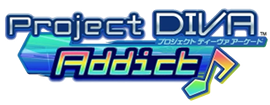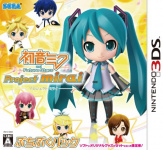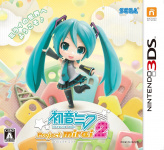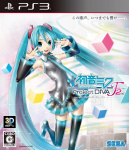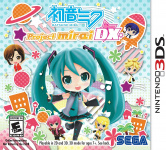Main Page
From Project DIVA Addict
From Wikipedia:
Hatsune Miku: Project DIVA is a series of rhythm games created by Sega and Crypton Future Media. The games have appeared on the PSP, Vita, PS3, and PS4. The series primarily makes use of Crypton Future Media's Vocaloids. The game is the first video game to utilize the Vocaloid software developed by the Yamaha Corporation.
Hatsune Miku: Project Mirai is a series of rhythm games created by Sega and Crypton Future Media for the 3DS. Core game play is similar to Project DIVA. The Project Mirai series features chibi versions of Crypton Future Media's Vocaloids and utilizes a different note track system. Gameplay is notably not as difficult as in Project DIVA. The series also features a guest-star Vocaloid (GUMI) from Internet Co., Ltd.
Games
Gameplay
The core goal in the series is to hit buttons in rhythm to the Vocaloids' singing. During extended vocal breaks, the player may be required to press buttons to the rhythm of the background music.
The buttons the player needs to hit, and their timing, are indicated by an icon & target system.
Players can select from five difficulties:
| Difficulty | All Versions | Project DIVA home versions | Project DIVA Arcade/Future Tone |
|---|---|---|---|
| Easy | Notes appear infrequently No/Minimum note switching |
Single button only (Circle) | Circle and Cross Only, no Multi-Notes |
| Normal | Notes appear normally Minimum note-switching |
PSP: Always Circle and Cross Vita/PS3/PS4: Circle and one other button |
All four buttons, no Multi-Notes |
| Hard | Notes appear frequently Regular note-switching |
All four buttons | All four buttons, some Multi-Notes |
| Extreme | Notes appear very frequently Frequent note-switching |
All four buttons | All four buttons, frequent Multi-notes |
| Extra Extreme | Notes appear very frequently Very frequent note-switching |
N/A | All four buttons, very frequent Multi-notes |
Notes:
- Project Diva 1st only has Easy, Normal, and Hard difficulties.
- Only Project Diva Arcade/Future Tone have the Extra Extreme difficulty.
- For Project Diva Arcade/Future Tone, Easy and Normal difficulties have a Challenge Time that temporarily bumps up the difficulty.
Scoring
The accuracy of the player's timing is judged on a scale: COOL, FINE/GOOD, SAFE, SAD/BAD, and WORST/AWFUL.
In all games except Project Diva X, there is a combo bonus that grows until the 50th note in the combo.
Chance Time
Chance Time is a feature of all home versions of Project DIVA. A player's life gauge is not affected during Chance Time.
Chance Time has worked differently throughout the series.
Project Diva (1st)
An extra bonus is applied to notes in a combo inside Chance Time. This bonus starts at +100 for the first note in a combo within Chance Time and grows to a max of +5000 for the 50th note in the combo. Every note in the combo after the 50th maintains a +5000 bonus. If a note is missed, the combo is broken and the bonus starts at +100 again. The number displayed at the end of Chance Time is the bonus the player earned while inside Chance Time. Maintaining a combo inside Chance Time is extremely crucial to getting a good score.
Project Diva 2nd & Extend
An extra bonus is applied to notes hit within Chance Time. This bonus is +1000 for COOLs and +600 for FINEs. Doubles are scored the same as singles. There is an extra bonus at the end of Chance Time that is awarded in increments of 10,000 based on the percentage of notes hit within Chance Time, with a max of 50,000 for a "perfect" Chance Time.
Project Diva F & F2nd
An extra bonus is applied to notes hit within Chance Time. This bonus is +1000 for COOLs and +600 for FINEs. There is no extra bonus at the end of Chance Time. Chance Time success is gauged by a star icon that fills up on hit notes as Chance Time progresses. If the gauge is filled and the player hits the final Star Note at the end, an alternate PV sequence is unlocked.
Project Diva X
No bonuses are given during Chance Time. Chance Time success is gauged by a star icon that fills up on hit notes as Chance Time progresses. If the Star Gauge is filled and the player hits the final note in Chance Time, the player will either unlock a random module (in Quest Mode) or switch modules in the middle of play (in Free Play, predetermined by the player at the song confirmation screen).
Challenge Time
Challenge Time is a feature of Project DIVA Arcade/Future Tone. It only appears on Easy and Normal difficulties. Difficulty is temporarily increased. A player's life gauge is not affected during Challenge time.
Technical Zones
Technical Zones were introduced in Project DIVA F. A player must hit all the notes inside a Technical Zone to pass it.
Rank
Rank is the result you get at the end of a song. MIS✕TAKE/DROP✕OUT, CHEAP/LOUSY, STANDARD, GREAT, EXCELLENT, and PERFECT.
Note: Project DIVA (1st) did not have an EXCELLENT rank.
In Project DIVA (1st) and Arcade/Future Tone, rank is determined by your score as a percentage of a max score.
In Project DIVA 2nd and Extend, rank is determined by the percentage of notes you hit with either COOL or FINE.
Grade Point System
In Project DIVA F, F 2nd, and X, Rank is determined by Rank Points.
| % of successful note hits × 89 | 89 |
| Chance Time Successful | 5 |
| % of Completed Technical Zones × 6 | 6 |
| TOTAL RANK POINTS | 100 |
Technical Specifications
| Games | Resolution | Frame rate | Frame dropping |
|---|---|---|---|
| Project DIVA PSP games | 480x272 | 30fps | Yes |
| Project DIVA PS Vita games | 960x544 | 30fps | Extremely Minimal |
| Project DIVA Arcade | 720p | 60fps | No |
| Project DIVA Dreamy Theater games | 720p | 60fps | No |
| Project DIVA F PS3 games | 1080p | 30fps | Extremely Minimal |
| Project DIVA PS4 games | 1080p | 60fps | No |
